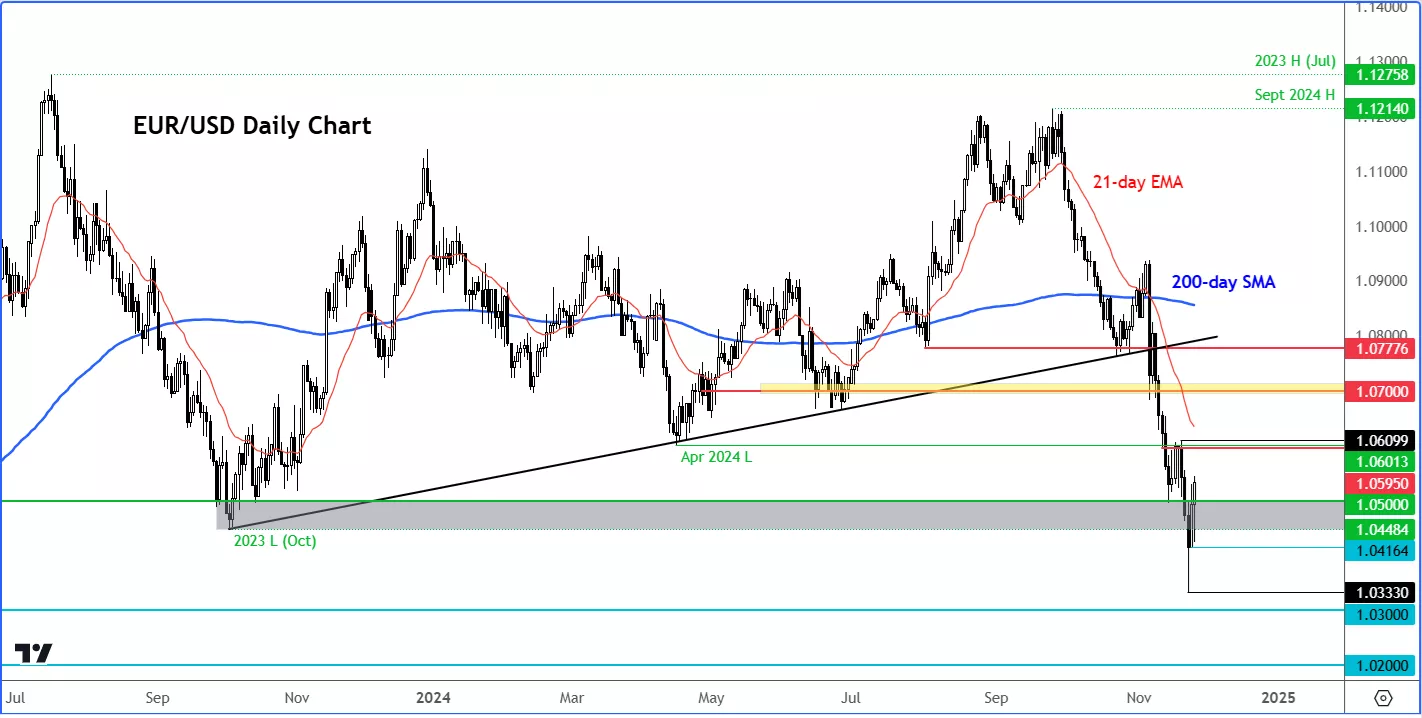 Image Source:
Image Source:
The euro rebounded after an initial drop, as Trump made no immediate tariff threats against eurozone exports. While his warnings appear to be negotiation tactics ahead of his January 20 inauguration, markets remain highly reactive to headlines, creating volatile trading conditions. Despite appointing Scott Bessent as Treasury Secretary, Trump’s potential use of executive orders underscores his direct leadership style. The brief cooling of the “Trump Trade,” characterised by a strong dollar and Bitcoin rally, may not last. For now, the euro is gaining short-term relief, though the .
Outlook far from ideal for euroOvernight we saw a big shake up in the FX space as currencies of Mexico, Canada, and China all came under pressure. Only one man could cause such a stir, and it was no other than President-elect Donald Trump, who threatened 25% tariffs on imports from Mexico and Canada unless they step up border security against illegal immigration, and to curb Fentanyl inflows from China. Relieved that there were no immediate mentions against eurozone exports, the euro managed to bounce back after a quick drop. While this move appears to be a negotiation tactic from Trump ahead of his January 20 inauguration, the market will increasingly become headline-driven and make for tricky trading conditions. Still, despite appointing a perceived safe pair of hands in Scott Bessent as Treasury secretary, one should not take lightly Trump’s verbal warnings as he could use executive orders to pass them through law. Indeed, if you recall from my note on Monday, I warned that Trump will be the ultimate boss and will lead from the front. And overnight he did really remind us who the boss was. Therefore, the slight cooling of the so-called “Trump Trade,” i.e., with a strong dollar cooling as we have seen thus far in the week (except against CAD and CNH that were hit by Trump’s tariff threat overnight), may not last long. But today, the euro is finding itself on the front foot amid the relief bounce that commenced from end of last week from severely technical oversold levels. While the recovery may end up lasting for a while, the EUR/USD outlook remains modestly bearish.
Euro rebound could be short-lived This week, we haven’t got much in the way of Eurozone date. On Monday, the German Ifo Business Climate survey offered new insights into business sentiment. Following last week’s weak PMI data, a positive surprise seemed unlikely, and the results confirmed this. The survey came in at 85.7, below both the previous 86.5 and expectations of 86.1.The euro’s recent struggles underscore investor concerns about the economic outlook in the Eurozone and China, as well as trade uncertainties in 2025 following Trump’s US election victory.Traders are closely monitoring eurozone data for improvement, but without positive signs, the euro may remain under pressure despite a strong start to the week. Last week’s composite PMI fell from 50 to 48.1, indicating contraction, with both services and manufacturing slowing. Weak export demand and declining business sentiment add to the gloom. While third-quarter GDP showed growth, fourth-quarter stagnation now appears likely, reinforcing a bearish euro sentiment.
What about US dollar and data? While it may have lost some momentum, the dollar has been on a strong bullish trend until the start of this week. But it is by no means it is the end of the bullish trend. Traders have been betting on Trump’s fiscal policies, including sweeping trade tariffs and measures to boost economic growth. The dollar index had risen for eight straight weeks through Friday. The momentum is thus quite strong and so this dollar weakness may prove to be short-lived, preventing the EUR/USD from turning bullish just yet.This is a shortened week due to Thanksgiving. Today’s include CB Consumer Confidence (expected to show an improvement to 111.8 from 108.7 last), New Home Sales, Richmond Manufacturing Index and FOMC minutes. On Wednesday, ahead of the Thanksgiving holiday, the US will release a flurry of data, including the second estimate of Q3 GDP, core PCE inflation, unemployment claims and durable goods orders.These reports could significantly influence the short-term EUR/USD direction, but it may not have any long-term impact as everyone is focused on what Trump will mean for the dollar next year. With many investors likely stepping away for the long holiday weekend, Friday could be a quieter day.
EUR/USD technical analysis and key levels to watch Source: TradingView.comThe fact that the EUR/USD has so far refused to hold below last year’s low of 1.0448 is a modestly positive sign, if it can hang around these levels. But the series of lower lows and lower highs should remind you that we that we have seen such recovery attempts only to be engulfed frequently by even sharper sell-off periods. Thus, without a solid technical evidence that rates have bottomed out, we could be in another such environment: corrective phase inside a larger bear trend. The EUR/USD is therefore far from bullish from a purely technical point of view, just yet.If the EUR/USD manages to build a base now around the 1.0450-1.0500 area (shaded in grey on the chart), then we may see it climb back towards the next resistance at 1.0600, and even higher towards the more significant hurdle around 1.0700 area. But if it goes back below that 1.0450-1.0500 area, then for me that would be the clearest indication yet that traders want to see even lower levels such as 1.0300, 1.0200 and so on.More By This Author:
Source: TradingView.comThe fact that the EUR/USD has so far refused to hold below last year’s low of 1.0448 is a modestly positive sign, if it can hang around these levels. But the series of lower lows and lower highs should remind you that we that we have seen such recovery attempts only to be engulfed frequently by even sharper sell-off periods. Thus, without a solid technical evidence that rates have bottomed out, we could be in another such environment: corrective phase inside a larger bear trend. The EUR/USD is therefore far from bullish from a purely technical point of view, just yet.If the EUR/USD manages to build a base now around the 1.0450-1.0500 area (shaded in grey on the chart), then we may see it climb back towards the next resistance at 1.0600, and even higher towards the more significant hurdle around 1.0700 area. But if it goes back below that 1.0450-1.0500 area, then for me that would be the clearest indication yet that traders want to see even lower levels such as 1.0300, 1.0200 and so on.More By This Author:
EUR/USD Extends Recovery But Don’t Expect It To Last – Here’s Why

